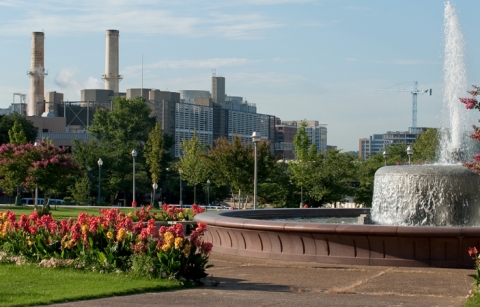
The Architect of the Capitol (AOC) completed a Long Term Strategic Energy Plan for the Capitol Power Plant (CPP), which identified cogeneration as the preferred solution for achieving energy savings, reducing environmental impacts, and maintaining a reliable source of chilled water and steam for Congress and the Supreme Court. The Cogeneration Plant at the CPP will use natural gas in a combustion turbine in order to efficiently generate both electricity and heat for steam.
The Plant Today: Natural Gas is the Primary Fuel Source
In existence since 1910, the Capitol Power Plant today serves 23 facilities on Capitol Hill including the Capitol Building, Capitol Visitor Center, House and Senate Office Buildings, the Supreme Court, the U.S. Botanic Garden, and the Library of Congress buildings. It has the design capacity to generate 620,000 pounds of steam per hour and 40,200 tons of refrigeration. The steam plant contains seven boilers, and the refrigeration plant houses seven electric-driven mechanical chillers that produce chilled water used for cooling.
Natural gas is the primary fuel source at the CPP. In order to save taxpayers’ money, the Architect of the Capitol is part of a government consortium for which the Defense Logistics Agency procures fuel. The procurement reserves a certain quantity of fuel for the AOC at a guaranteed price; this does not mean the AOC will use the coal on reserve.
In case of a natural disaster, federal emergency or fuel shortage, the procurement allows the Plant the resources necessary to stay online in support of Congressional operations.
Reducing Greenhouse Gas: Improving the Plant through Cogeneration
Cogeneration is a proven technology that utilizes natural gas to generate two products – electricity and steam. Installing a cogeneration plant increases system reliability, improves efficiency, and helps save taxpayer money.
As part of the AOC’s Strategic Long-Term Energy Plan for the CPP, cogeneration technology was identified as an energy efficient and cost effective means to meet future energy requirements by generating on-site power.
It significantly reduces greenhouse gas emissions, thereby helping to improve the air quality in the District of Columbia, and would allow for a reduction in the use of coal at the CPP.
Cogeneration has been successfully implemented at other federal facilities including NIH and GSA.
Permitting Process
The Architect of the Capitol applied to the District Department of the Environment (DDOE) for Plantwide Applicability Limit (PAL) permits and Chapter 2 construction permits. In addition, the AOC submitted an application for a PAL permit from the Environmental Protection Agency (EPA). The EPA issued its permit for the cogeneration project Janaury 23, 2013, the DDOE issued its permit June 5, 2013 (news release).
The permits do not allow CPP to return to coal burning, as some have suggested, because the plant currently burns limited coal as it has since the early 1900s. The proposed permits would also not roll back emission limits in order to allow the power plant to burn more coal. The permits significantly lower the emission limits at the power plant and therefore limit the amount of coal that CPP can use.
More information available at District Department of the Environment (DDOE).
Additional resources available for download:
- Fact Sheet about Cogeneration at the Capitol Power Plant (pdf)
- Frequently Asked Questions about Air Permitting (pdf)
Please contact AOC Communications Office at 202.228.1793 for questions about this project.





